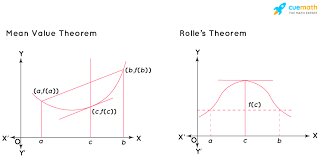MVT, 1st & 2nd Deriv Test
Mean Value Theorem:
Conditions: f is continuous on [a,b] and differentiable on (a,b)
MVT guarantees one value c on (a,b) where slope of tangent line = slope of secant line
f’(c) = (f(b)-f(a))/b-a *slope formula
Rolle’s Theorem
if f(a)=f(b) then you can say there is a value c where f’(c)=0
 Increasing or decreasing?
Increasing or decreasing?
if f’(x)>0 for (a,b), then f is increasing on [a,b]
if f’(x)<0 for (a,b), then f is decreasing on [a,b]
if f’(x)=0 for (a,b), then f is constant on [a,b]
1st Derivative Test
if f’(x) changes from + to - at x=c, then (c,f(c)) is a relative max for f
if f’(x) changes from - to + at x=c, then (c,f(c)) is a relative min for f
Concave up or down?
if f’’(x)>0 for (a,b), then f is concave up on (a,b)
if f’’(x)<0 for (a,b), then f is concave down on (a,b)
Inflection points occur when:
f’’(x)=0 or undefined
f’’(x) changes signs (+ to - or - to +)
f’(x) changes from inc to dec or dec to inc
2nd Derivative Test
if f’(c)=0 and f’’(x)>0 (concave up), then f has a local MIN at x=c
if f’(c)=0 and f’’(x)<0 (concave down), then f has a local MAX at x=c